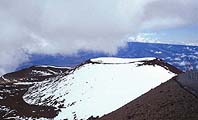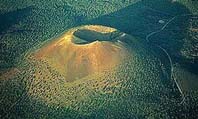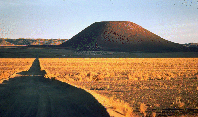
Scoria cones, also known as cinder cones, are the most common type of volcano. They are also the smallest type, with heights generally less than 300 meters. They can occur as discrete volcanoes on basaltic lava fields, or as parasitic cones generated by flank eruptions on shield volcanoes and stratovolcanoes. Scoria cones are composed almost wholly of ejected basaltic tephra. The tephra is most commonly of lapilli size, although bomb-size fragments and lava spatter may also be present. The tephra fragments typically contain abundant gas bubbles (vesicles), giving the lapilli and bombs a cindery (or scoriaceous) appearance. The tephra accumulates as scoria-fall deposits which build up around the vent to form the volcanic edifice. The edifice has very steep slopes, up to 35 degrees, although older eroded scoria cones typically have gentler slopes, from 15 to 20 degrees. Unlike the other two main volcano types, scoria cones have straight sides and very large summit craters, with respect to their relatively small edifices. They are often symmetric, although many are asymmetric due to (1) the build up of tephra on the downwind flank of the edifice, (2) elongation of the volcano above an eruptive fissure, or (3) partial rafting of an outer wall of the volcano due to basalt lava oozing outward from beneath the volcano edifice. Where scoria cones have been breached, they typically reveal red-oxidized interiors.

|

|
|
|
|

|
La Poruna scoria cone |
Scoria cones are generated by Strombolian eruptions, which produce eruptive columns of basalt tephra generally only a few hundred meters high. Many scoria cones are monogenetic in that they only erupt once, in contrast to shield volcanoes and stratovolcanoes. An exception is the Cerro Negro volcano in Nicaragua, which is the Earth's most historically active scoria cone. It is one of several parasitic cones on the northwest flank of Las Pilas volcano. Cerro Negro has erupted more than twenty times since it was born in 1850. Its most recent eruptions were in 1992 and 1995.
Go to: